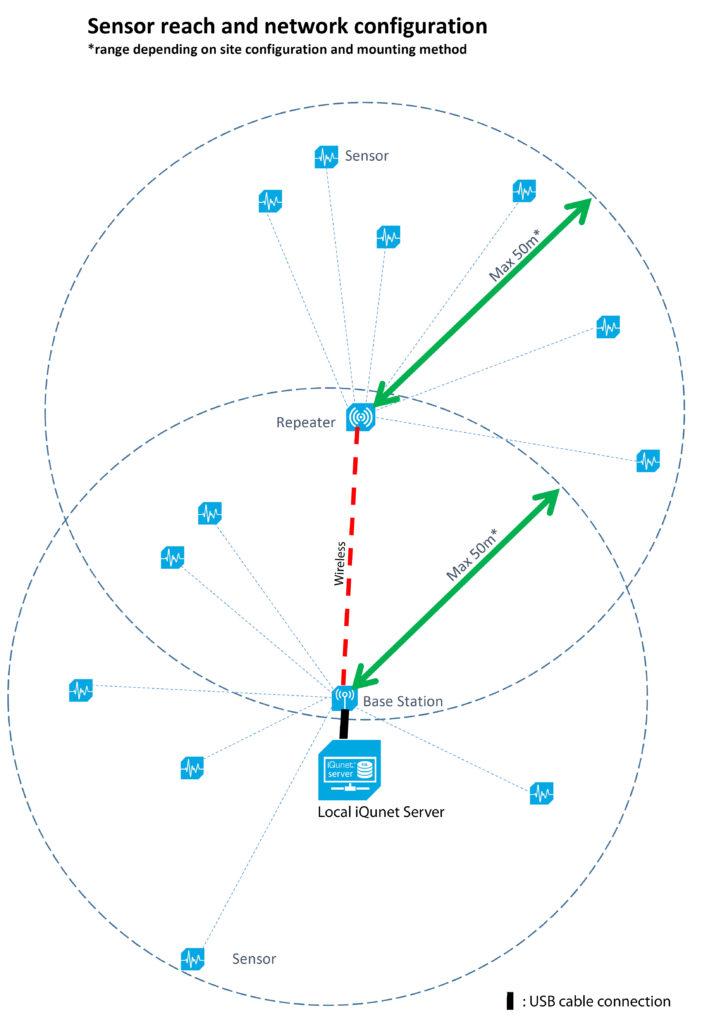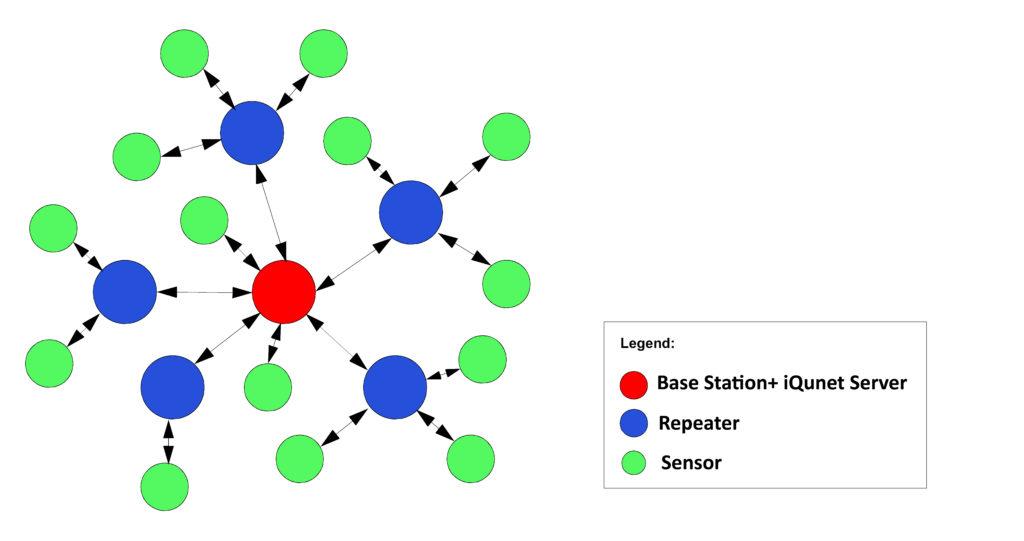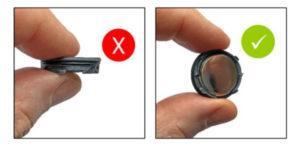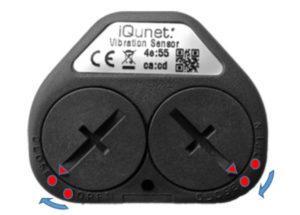- No products in the cart.
- No products in the cart.
Frequently Asked Questions
Frequently Asked Questions
Q1: How many wireless sensors can the iQunet sensor network manage?
Virtually unlimited. There is no limit on the number of sensors in one iQunet sensor network. You can also combine different sensor types in one network. The central node is the Base Station. All data gathered by the sensors is stored on the iQunet Server attached to the Base Station.
Q2: What is the range of a wireless iQunet sensor?
The range of a sensor is a few hundreds of meters in free field. In industrial plants the range is less due to interference and reflections. If the sensor is mounted according to our instructions you can reach up to 50m in a rather open plant. In a very dense plant with metal constructions all over, the range will be up to 30m. If a sensor or the Base Station is put in a metal cabinet, the range will drop to less than 10m. You can always check the RSSI symbol in the dashboard to find out if the sensor is able to connect to the Base Station. Due to limitations in the free frequency bands, we are not allowed by governmental rules to increase broadcasting power – although we could.

Q3: Can I extend the range of the sensor network?

Yes, you can! Use an iQunet Repeater to extend the range of the sensor network. You can add an unlimited number of Repeaters in the range of the Base Station. Each Repeater can serve also an unlimited number of sensors. Nevertheless, each sensor might not see more than one Repeater between sensor and Base Station. More Repeater hops in the network will drastically increase the uptime of the radio transmitters in the sensors. By avoiding this, we can guarantee a long battery life.
Q4: What is the battery life time of the 2 batteries in the sensors?
Remark: more information regarding the calculation of the battery lifetime will be available shortly in this Google Sheets file.
The iQunet sensor is designed to do 1 wireless measurement every day. This gives you 365 times more measurements than with 1 manual measurement per year. Approximately 10000 measurements can be made per battery pair. The battery life therefore depends on the sensor settings you enter on the Sensor Dashboard.
For example, the batteries of the Vibration Sensor last up to 5 years if one vibration measurement of 4096 samples is taken every day over the three axes. Each axis counts as 1 measurement.
10000/3/365 = 9.1 years> ± 5 years
Taking into account battery leakage we assume a life time of about 5 years for measurements of 4096 samples and a wake-up time of more than 60 seconds.
At 1 measurement per minute this gives in theory a lifetime of: 10000/3/(60 × 24) = 2.3 days
At 1 measurement per hour, this theoretically gives a lifetime of: 10000/3/24 = 138.9 days
An important note here is that the batteries must be installed clean. The sensor electronics are extremely low power. For example, touching the CR2032 coin cell batteries will leave some grease on the batteries causing a leakage current to run over the battery poles. This shortens the lifespan of the sensor by up to 50%!
It is also important to make sure that the sensor is well within the wireless range of the Base Station. If the sensor is at the limit of this range, battery consumption will increase because of the extra connections necessary for data transfer.


Q5: How can I maximize my battery life?
The following tips can help you to make your batteries last longer:
- Make sure to install the batteries clean. For example, touching the CR2032 coin cell batteries will leave some grease on the batteries causing a leakage current to run over the battery poles. This shortens the lifespan of the batteries by up to 50%.
- Make sure that you have the latest iQunet Server software version installed.
- Make sure that there is a good connection between the sensor and the Base Station (directly or via the optional Repeater). A weak connection will cause poor transfer of measuring data which will result in extra transfer time/use of the battery power.
- Set the wake-up interval of the sensor to 2 minutes.
- Reduce the number of measurements per day (to for example 1 measurement each day). Per battery pair there are approximately 3300 measurements of 2048 samples available per measurement axis.
- Reduce the number of samples (2048 samples is in most cases a good long term setting).
- For bearing follow up at a sampling rate of 3200Hz one measurement will take 0.64 seconds.
- For follow up of slower turning machines at a sampling rate of 1600Hz one measurement will take 1.28 seconds.
- Reduce the number of measurement axes. Sometimes a measurement axis is not relevant.
- Make sure to set a threshold level to avoid making measurements when the machine is idle.
- Use the integrated Anomaly Detection Service of iQunet for adequate follow up with a minimum of measurements.
Q6: Where is my data stored? Do I have to pay a cloud fee?
The sensor measurements are stored on the iQunet Server you buy with the sensors and network components. This server runs several processes and contains a database. (We compute “in the edge – not in the cloud”) The OPC UA Server allows you to access the data free of charge from any OPC UA client. There is no lock-in, nor are there any fees to be paid. It is the vision of iQunet that data collected by the customer belongs to the customer without fees. Of course, you will need stable network access to address the server and to visualize the data or to extract data using the OPC UA Server communication.
Q7: Do I have to install software and buy licenses to setup and monitor the sensor network?
There is no need to install any additional software apart from your browser in order to access the iQunet Sensor Dashboard. Furthermore, there are no license fees to be paid. When you purchase the product, you have already paid for both the hardware and the pre-installed software. We recommend using a Chrome browser, although any browser that is webRTC ready will work fine. You can check if your browser supports this open-source development by visiting http://iswebrtcreadyyet.com/legacy.html. Additionally, you have the option to access the Sensor Dashboard using a webRTC compatible browser on various devices, including smartphones, tablets, and more.
Kindly be aware that while the software embedded on the iQunet hardware is provided free of charge, certain services and licenses are not included and must be ordered separately. These additional offerings encompass the iQunet Support and Repair Services, the Anomaly Detection Service (AI-aaS), the iQunet-CloudLink Database Service (DBaaS), and the LoraWAN sensor payload decoder license.
Q8: What happens if the internet or intranet fails?
As long as the Servers (and Repeaters) are connected to the mains, data collection and monitoring remains ongoing, even without internet/intranet connection. The iQunet sensor network stays up and running because we compute “in the edge”, not in the cloud. Data is stored nearby the sensor network. Only visualization (via browser) is done over the network.
Q9: I am making a test with the Vibration Sensor, and I am observing that I measure 1gRMS when the sensor is measuring nothing (I only put it on the table). Why is this happening?
The Vibration Sensor contains an acceleration MEMS chip. Even when on the table, the sensor measures gravity. Depending on how it lays on the table you will find +1g or -1g on the axis that is in line with gravity. You can set the high pass filter in the Sensor Dashboard to filter out the gravity measurement in the graphs.
Q10: Is it possible to attach a magnetic base to the wireless sensor without interfering the wireless signal quality?
Yes, you can. Sensors like the standard Vibration Sensor are not sensitive to magnets. This allows you to mount the sensor on a magnetic base and start online measuring in no time. Other sensors like the Proximity Sensor measure the magnetic field, and it is obvious that mounting such a sensor on a magnetic base makes little sense.
Q11: Why are the iQunet Vibration Sensors not calibrated?
The iQunet Vibration Sensors are not calibrated because the calibration would only be valid for a specific frequency and temperature. Since these parameters cannot be kept stable in a real industrial environment and a calibration procedure per sensor is expensive, iQunet has chosen for a more practical solution.
Instead of (re)calibrating each sensor each year, iQunet keeps track of several trends, on top of the time signal, of the vibration signal (for example RMS). Based on these trends deviations can be detected automatically, where one-time measurements must work with prefixed threshold values. Since the sensor doesn’t need to be removed for calibration, it can remain mounted on an identical spot. This will lead to consistent trend tracking measurements. Since the iQunet sensors work completely wireless, there is also no risk of variable contact surface, modified measuring points, interference on the cabling or even an incorrectly performed measurement. Problems in the machine on the short term can thus be detected faster, even without calibration.
Since the sensor doesn’t need calibration, the maintenance costs per sensor are much lower and the sensor design is simpler which results in a lower current consumption and a longer battery life time.
Finally, the peak frequencies in the Fourier spectrum are dependent on the rotation speed. Even if the rotation speed is theoretically constant, there will be an unknown shift in the spectrum caused by the variable motor load, variations in the frequency control of the motor, etc. These shifts are however constant across the whole spectrum. Because of this, orders of the fundamental frequencies (1X, 2X, 3X, etc.) can be used in the spectrum. The same principle applies for a noncalibrated iQunet sensor.
Q12: How do the iQunet sensors measure temperature?
All our industrial sensors have a temperature sensor chip on board. This electronic chip is situated on the PCB inside the sensor unit and measures the mass temperature from the wireless sensor. There will be some delay between the surface temperature of the sensor unit and the collected inside temperature. These build-in temperature sensors have a measurement range of -20°C to +70°C and an accuracy of +-0.5°C (max). Temperature is automatically logged every 15 minutes. The sensors should remain within the wireless range of the Base Station (be in contact with it) at all times.
Q13: What happens if the wakeup interval is larger than the queue interval of the sensor?
The wakeup interval is an internal parameter of the iQunet sensors and indicates the maximum time interval at which the sensor must exit sleep mode and contact the Base Station to collect its scheduled tasks. If no task has been scheduled for this sensor or if the Base Station could not be contacted (for example because the Base Station is out of range), the sensor will return to sleep mode for the wakeup interval period. The purpose of the wakeup interval is to extend the battery life time.
The queue interval defines the time interval between two automatic measurements.
If the wakeup interval is larger than the queue interval, the measurements will only take place when the sensor goes out of sleep mode. When the sensor wakes up, it will contact the Base Station for pending measurements.
Q14: Why are my settings lost after power off?
To prevent corruption of the database in case of power loss and to prevent early SD card wear due to writing small data blocks, the internal database is used in WAL mode (write ahead logging). This means that the data transactions are not executed immediately but are stored in small shared-memory files. These files are flushed to the main database every 900 seconds or 1000 database writes, whichever comes first.
As the dashboard currently doesn’t provide any means for a forced write to the database, it is advised to wait 15 minutes before powering off the system to make sure that the checkpoint timeout has occurred, and settings have been written to the database. We will provide a solution for this in a future release.
Q15: Can I monitor already installed analog sensors with the iQunet sensor network?
We recently developed the iQunet Wireless Sensor Bridge system. The Sensor Bridge is a 24VDC or 5.1VDC powered device that can accept up to 3 interchangeable plug-in modules for the digitalization of analog monitoring sensors. Every module accepts an analog signal from one 1-axial IEPE compatible device and converts this analog signal to digital. The digital signal is then transferred wireless to the iQunet Server via the built-in Bridge Repeater module where it is stored in the OPC database together with its time stamp. In this way you will be able to combine existing monitoring sensors and wireless iQunet sensors and store the values in one database for further processing.

